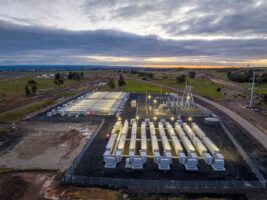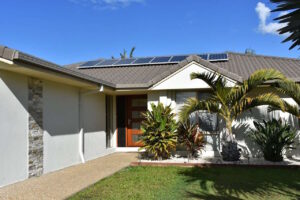Australia’s nuclear energy debate reaches Peak Idiocy this week with the visit of Jessica Lovering from the U.S. Breakthrough Institute.
Lovering has and will be speaking at public events alongside Australian university student Ben Heard. Both the Breakthrough Institute and Heard’s ‘Bright New World’ present themselves as progressive environment groups but they are single-issue, pro-nuclear lobby groups with little interest in broader environmental issues. Australia’s environment groups ‒ i.e. real environment groups ‒ are united in our opposition to nuclear power.
Real environment groups celebrate the spectacular growth of renewables and the spectacular cost reductions whereas pro-nuclear lobby groups, including Lovering’s Breakthrough Institute and Heard’s Bright New World, are on a never-ending campaign against renewables.
Global renewable energy capacity has doubled over the past decade and current renewable capacity of 2,006 gigawatts (GW) is 5.1 times greater than nuclear power capacity of 392 GW (including idle reactors in Japan). Actual electricity generation from renewables (23.5% of global generation) is more than double that from nuclear power (10.7%) and the gap is widening every day.
Lovering’s opinion piece in The Australian on Monday fails to note that her speaking trip is sponsored by the Minerals Council of Australia. Likewise, Heard has also been paid as a uranium industry consultant.
Lovering brings a suitcase full of alternative facts to Australia. The most egregious is that the nuclear industry is in the middle of some sort of renaissance. Even her own institute contradicts this, bleating about nuclear power’s “rapidly accelerating crisis“, a “crisis that threatens the death of nuclear energy in the West“, “the crisis that the nuclear industry is presently facing in developed countries“, the “ashes of today’s dying industry”, and noting that “the industry is on life support in the United States and other developed economies“.
As discussed in RenewEconomy in April, the industry is definitely in crisis. US nuclear giant Westinghouse has filed for bankruptcy protection. Westinghouse’s parent company Toshiba states that there is “substantial doubt” about Toshiba’s “ability to continue as a going concern”. These industry giants have been brought to their knees by cost overruns ‒ estimated at US$13 billion ‒ building four power reactors in the U.S.
Likewise, French nuclear utilities EDF and Areva survive only because of repeated, multi-billion-dollar bailouts by the French government. The combined cost overruns for two French EPR reactors under construction in France and Finland amount to at least US$13.5 billion. South Korea is now looking to exit the industry.
As the Breakthrough Institute’s Michael Shellenberger wrote in February:
“Nuclear energy is, simply, in a rapidly accelerating crisis:
-
Demand for nuclear energy globally is low, and the new reactors being built may not keep up with the closure of nuclear plants around the world. Half of all U.S. nuclear plants are at risk of closure over the next 13 years.
-
Japan has only opened two of its 42 shuttered nuclear reactors, six years after Fukushima. Most experts estimated it would have two-thirds open by now. The reason is simple: low public acceptance.
-
While some still see India as a sure-thing for nuclear, the nation has not resolved key obstacles to building new plants, and is likely to add just 16 GW of nuclear by 2030, not the 63 GW that was anticipated.
-
Vietnam had worked patiently for 20 years to build public support for a major nuclear build-out before abruptly scrapping those plans in response to rising public fears and costs last year. Vietnam now intends to build coal plants.
-
Last month Entergy, a major nuclear operator, announced it was getting out of the nuclear generation business in states where electricity has been de-regulated, including New York where it operates the highly lucrative Indian Point.”
Lovering’s solution to the nuclear power crisis is to sell moonshine. From The Australian on Monday: “Advanced nuclear designs have the capability to be meltdown-proof, using a combination of coolants, fuels, and basic physics. Reactors that are intrinsically safe can also be radically cheaper, especially by making much smaller, modular reactors in factory settings.”
But the only ‘meltdown-proof’ reactors are those that come pre-melted, i.e. concepts based on liquid nuclear fuels. As the UK Royal Society notes: “There is no proliferation proof nuclear fuel cycle. The dual use risk of nuclear materials and technology and in civil and military applications cannot be eliminated.”
As for small modular reactors (SMRs), only a few are under construction: one in Argentina, a twin-reactor floating nuclear power plant in Russia, and three SMRs in China (including two high-temperature gas-cooled reactors). The broad picture for SMRs is much the same as that for fast neutron reactors: lots of hot air, some R&D, but few concrete plans and even fewer concrete pours.
There isn’t the slightest chance that SMRs will fulfil the ambition of making nuclear power “radically cheaper” unless and until a manufacturing supply chain is mass producing SMRs for a mass market ‒ and even then, it’s doubtful whether the power would be cheaper and it is inconceivable that it would be “radically cheaper”. After all, economies-of-scale have driven the long-term drift towards larger reactors.
As things stand, no country, company or utility has any intention of betting billions on building an SMR supply chain. The prevailing scepticism is evident in a February 2017 Lloyd’s Register report based on “insights and opinions of leaders across the sector” and the views of almost 600 professionals and experts from utilities, distributors, operators and equipment manufacturers.
Respondents predicted that SMRs have a “low likelihood of eventual take-up, and will have a minimal impact when they do arrive”.
In the absence of a mass supply chain, SMRs will be expensive curiosities. The construction cost of Argentina’s 25-megawatt CAREM reactor is estimated at US$446 million, which equates to a whopping US$17.8 billion/GW. Estimated construction costs for the Russian floating plant have increased more than four-fold and now equate to over US$10 billion / GW.
Ben Heard thinks Australia should take the lead building his preferred version of Generation IV fast neutron reactors. So Australia ‒ a country with virtually no relevant expertise and even less experience ‒ should take the lead developing Generation IV reactors despite the fact that global nuclear industry giants face crippling debts and possible bankruptcy due to cost overruns building a handful of conventional reactors?
That proposition is beyond stupid and it was even rejected by the (stridently pro-nuclear) SA Nuclear Fuel Cycle Royal Commission last year. The Royal Commission said:
“[A]dvanced fast reactors and other innovative reactor designs are unlikely to be feasible or viable in the foreseeable future. The development of such a first-of-a-kind project in South Australia would have high commercial and technical risk. Although prototype and demonstration reactors are operating, there is no licensed, commercially proven design. Development to that point would require substantial capital investment. Moreover, electricity generated from such reactors has not been demonstrated to be cost competitive with current light water reactor designs.”
Lovering offers one more alternative fact ‒ the claim that South Australia could accrue A$6 billion in annual economic benefits by importing vast amounts of nuclear waste from around the world.
That claim was tested by the Nuclear Economics Consulting Group, commissioned by a Joint Select Committee of the SA Parliament.
The NECG report notes that the $6 billion claim, presented in the SA Nuclear Fuel Cycle Royal Commission’s 2016 report, fails to consider some important issues which “have significant serious potential to adversely impact the project and its commercial outcomes”; that assumptions about price are “overly optimistic” in which case “project profitability is seriously at risk”; that the 25% cost contingency for delays and blowouts is likely to be a significant underestimate; and that the assumption the project would capture 50% of the available market had “little support or justification”.
Dr Jim Green is the national nuclear campaigner with Friends of the Earth.











